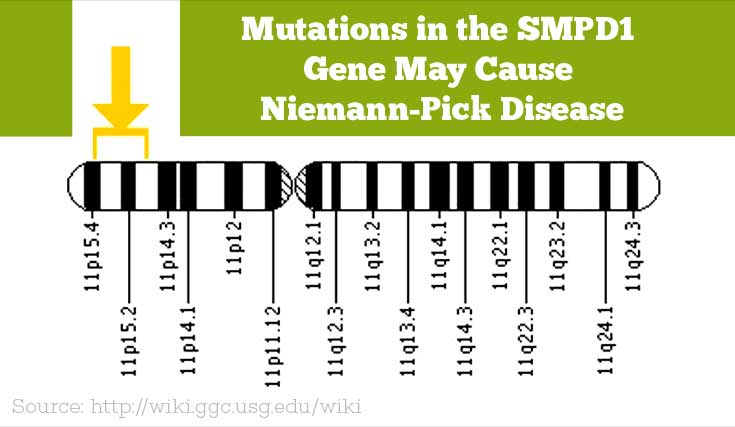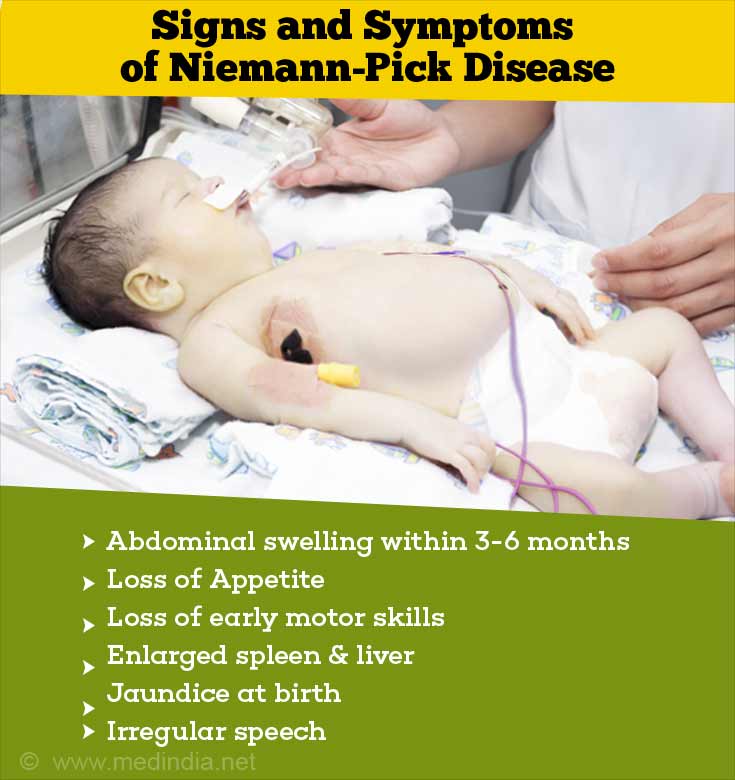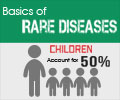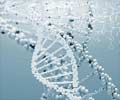- Niemann-Pick Disease Overview � Types A, B and C - (http://nnpdf.org/overview/)
- Niemann-Pick Disease Wikipedia - (https://en.wikipedia.org/wiki/niemann%e2%80%93pick_disease)
- Niemann-Pick Disease - (https://ghr.nlm.nih.gov/condition/niemann-pick-disease)
- Harrison’s Principles of Internal Medicine 18th Edition
- The Merck Manual
- A. D.A.M. Medical Encyclopedia
What is Niemann-Pick Disease?
Niemann-Pick disease is a group of inherited metabolic disorders in which cholesterol and fatty substances called lipids collect in the lysosomes because the body is unable to metabolize them. It belongs to a group of more than 50 disorders called lysosomal storage diseases.
Lysosomes are membrane-bound compartments within cells that contain enzymes to break down large molecules such as proteins, carbohydrates and fats into their building blocks. If there is abnormal functioning of an enzyme, the body is unable to metabolize cholesterol and other fatty substances (lipids) inside of cells; this leads to their accumulation in various tissues of the body, including brain tissue. Cells then malfunction and die leading to organ damage.
Organelles that can get affected in Niemann-Pick disease are the brain, nerves, liver, spleen, bone marrow and, in severe cases, lungs.
The disease can occur at any age but mainly affects children. There is no known cure for the disease and it can be fatal sometimes. Hence treatment is focused on helping people live with their symptoms.
What are the Types of Niemann-Pick Disease?
Niemann-Pick disease is currently classified into two types. Older classification had types A, B, C and D.
- Niemann-Pick disease, SMPD1-associated that includes Types A and B. Niemann-Pick disease Types A and B is characterized by the deficiency of an enzyme called acid sphingomyelinase (ASM). This enzyme is required for breaking down sphingomyelin, which is a product of fat metabolism. The lack of ASM leads to the collection of sphingomyelin or cholesterol in the body.
- Niemann-Pick disease, Type C which includes type C1 and C2. Type D is caused by the same gene as Niemann-Pick disease type C1. Hence, type C Niemann-Pick incorporates type D from the older classification. Niemann-Pick disease Type C (NPC) arises due to a defect in cholesterol and glycolipid transport mechanisms.
Facts and Statistics on Niemann-Pick Disease
- Niemann-Pick disease types A and B most frequently affect individuals of Ashkenazi (eastern and central European) Jewish descent.
- The incidence of Niemann-Pick disease, SMPD1-associated (i.e. both type A and type B) is estimated to be 1 in 250,000.
- Niemann-Pick disease type B is found mostly in the Maghreb region (Tunisia, Morocco, and Algeria) of North Africa).
- Type C disease occurs more frequently in people of French-Acadian descent in Nova Scotia (incidence of about 1 in 150,000) and Spanish-American population of southern New Mexico and Colorado.
What are the Causes of Niemann-Pick Disease?
Niemann-Pick disease types A and B arise due to mutations in the SMPD1 gene. It is a hereditary disease that inherits in an autosomal recessive pattern. This gene is required by the cells to produce an enzyme called acid sphingomyelinase (ASM). Changes in the structure of this gene (mutations) lead to deficiency of the enzyme. As a result of this a fatty substance called sphingomyelin (normally digested by the enzyme) cannot be metabolized properly and is accumulated within the cell. This ultimately leads to cell death and the malfunction of major organ systems.
Patients with Niemann-Pick disease, type C are known to share specific mutations in NPC 1 and NPC2 genes. These mutations disrupt the body’s cholesterol and glycolipid transport mechanisms leading to the abnormal accumulation of these entities.

What is the Inheritance of Niemann-Pick Disease?
Niemann-Pick disease is a hereditary disease that inherits in an autosomal recessive pattern, i.e. two copies of an abnormal gene must be present in order for the disease to develop. The parents of a child with an autosomal recessive disorder do not have the disease clinically in most cases though they carry one copy of the altered gene. This state is referred to as the ‘carrier state’. If both parents are carriers, there is a 25% chance with each pregnancy for an affected child.
What are the Signs and Symptoms of Niemann-Pick Disease?
Symptoms of Type A
These usually begin in the first few months of life and include:
- Abdominal swelling within 3-6 months
- Cherry-red spot in the eye
- Feeding difficulties
- Loss of Appetite
- Loss of early motor skills
Symptoms of Type B
There is almost no brain and nervous system involvement in Niemann-Pick disease type B. Symptoms are usually milder and occur in late childhood or adolescence. Abdominal distension and repeated respiratory infections are common.
Symptoms of Type C
Type C commonly affects school-aged children. Symptoms include:
- Difficulty in moving limbs (termed dystonia)
- Enlarged spleen (splenomegaly)
- Enlarged liver (hepatomegaly)
- Jaundice at birth or shortly after birth
- Learning difficulties and intellectual disability (dementia)
- Seizures
- Slurred, irregular speech
- Sudden loss of muscle tone which may lead to falls (cataplexy)
- Tremors
- Trouble moving the eyes up and down (vertical supranuclear gaze palsy)
- Unsteady gait, clumsiness, walking problems (ataxia)

What is the Diagnosis for Niemann-Pick Disease?
- Blood or bone marrow samples can be used for measuring the amount of acid sphingomyelinase (ASM) in white blood cells to diagnose Niemann-Pick disease type A and B. These tests are not useful in identifying the carriers of the disease (i.e. those who carry the mutation, but do not have the clinical disease). For this purpose, DNA tests are indicated
- Type C can be diagnosed by skin biopsy where a sample of skin is taken to examine how the cells move and store cholesterol. In the neonatal period, blood-based testing for biomarkers (oxysterols, lysosphingolipids, bile acid metabolites) and molecular gene sequencing of NPC1 and NPC2 are current options. Combining diagnosis by biomarkers and gene sequencing has improved the detection rate (sensitivity) and accuracy (specificity) of diagnosing NPC beyond the neonatal period.
Other tests employed include:
- Bone marrow aspiration where the technician will take a sample of the soft tissue that is inside the bones. While not a very sensitive method, it is typically performed for patients with NPC, where macrophages with abnormal cholesterol storage or foam cells, can be detected in the bone marrow.
- Slit-lamp examination of the eye.
- Liver biopsy (not always required).
Techniques like chorionic villus sampling or amniocentesis can be used for ante natal diagnoses. After birth, the diagnosis can be made by a liver biopsy where liver tissue specimens are studied under a microscope.
What are the Complications of Niemann-Pick Disease?
- Blindness
- Infections
- Brain damage with mental retardation and delayed development of physical skills
- Deafness
- Death
What is the Treatment for Niemann-Pick Disease?
None of the types of Niemann-Pick disease can be cured completely. Treatments are limited and thrive on supportive measures. Type A disease has no effective treatment currently. Enzyme replacement therapy, bone marrow transplantation, and gene therapy are being studied for type B disease. New drugs like miglustat have started to make appearance in the treatment of type C disease. Miglustat inhibits glucosylceramide synthase, an enzyme that takes part in the synthesis of glycosphingolipids, whose accumulation occurs excessively in Niemann-Pick disease.
Although Niemann-Pick disease does not have a complete cure yet, new treatments that halt the disease progression are being studied. Affected children tend to die of infection or progressive dysfunction of the central nervous system.
What is the Prognosis of Niemann-Pick Disease?
Niemann-Pick is a fatal disease, the most serious form being type A disease. Children with type A disease do not usually survive beyond the age of 2 or 3 years. Type B patients may live into late childhood or adulthood.
Prognosis of type C depends on the time of onset of symptoms; the earlier the appearance of symptoms, worse is the prognosis. Patients with late onset of symptoms have survived up to 20 years of age.
 MEDINDIA
MEDINDIA

 Email
Email






